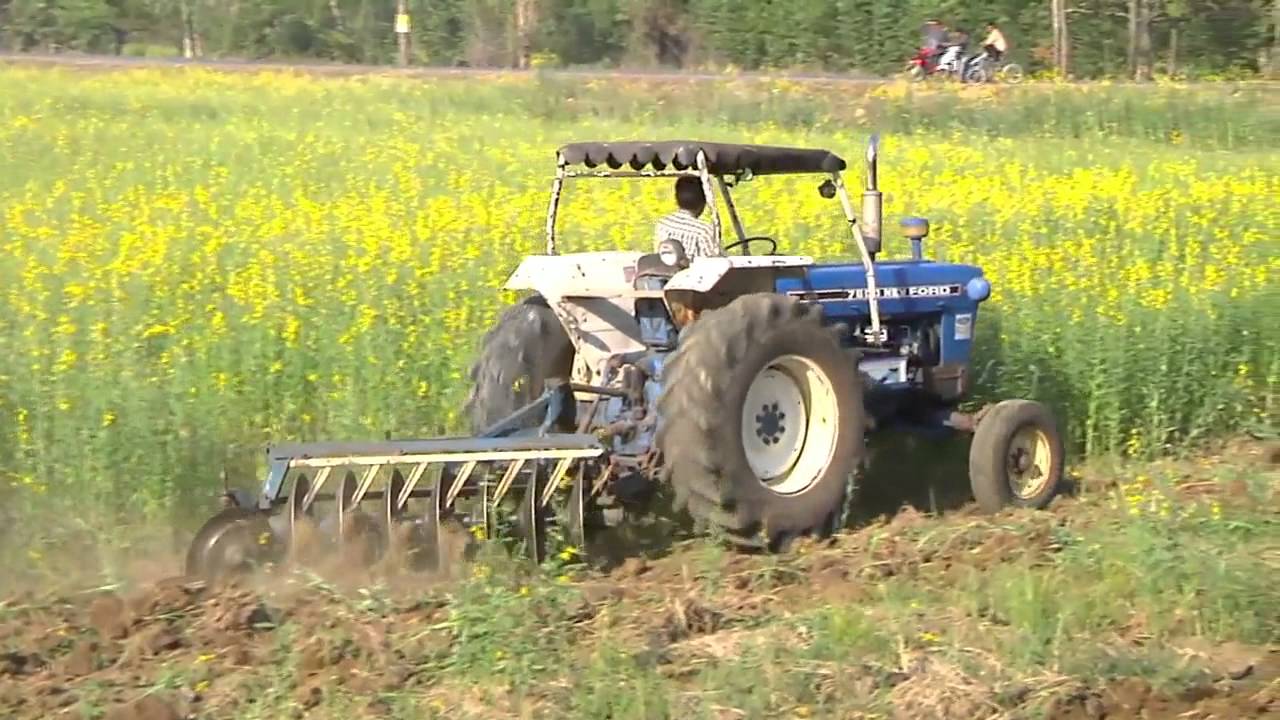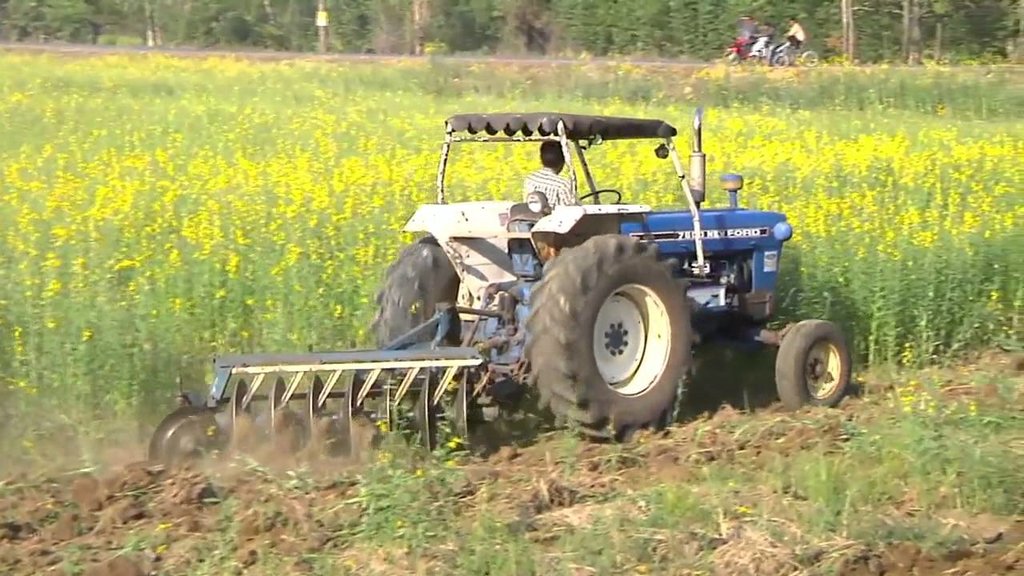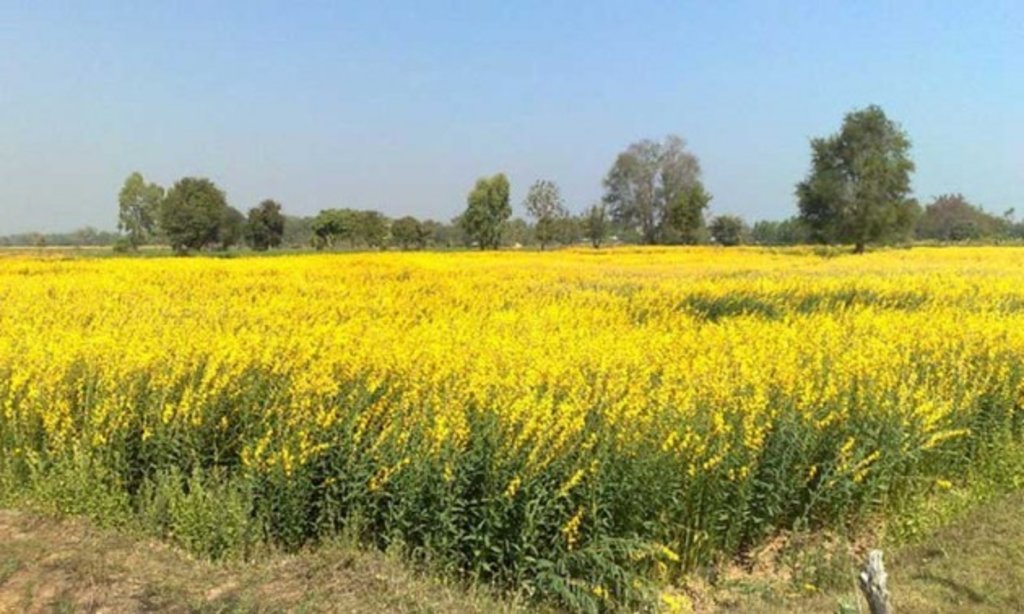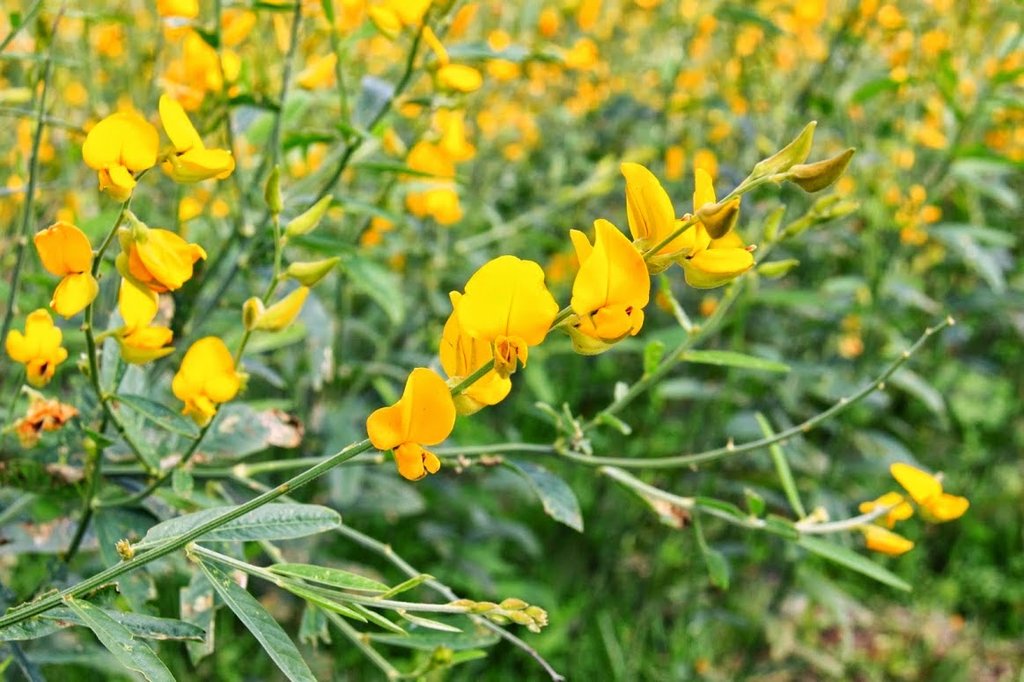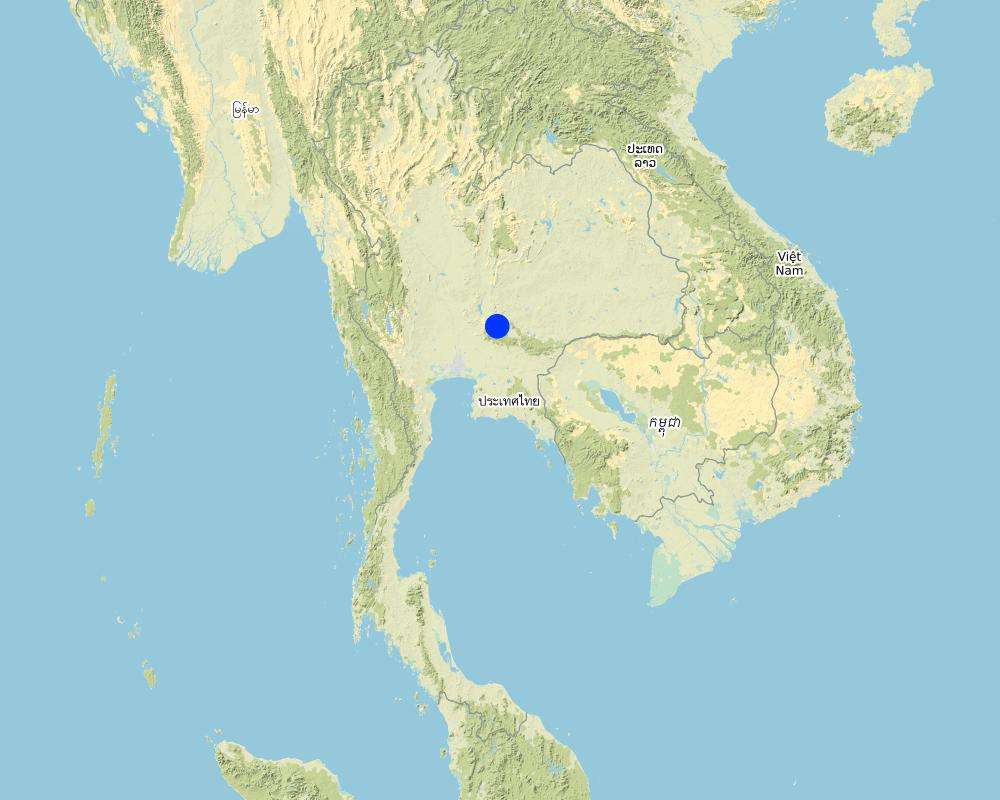Planting sunn hemp as green manure for soil improvement [Thailand]
- Creation:
- Update:
- Compiler: Bunjirtluk Jintaridth
- Editor: –
- Reviewers: Rima Mekdaschi Studer, Pitayakon Limtong, William Critchley
Por Toeng
technologies_4336 - Thailand
View sections
Expand all Collapse all1. General information
1.2 Contact details of resource persons and institutions involved in the assessment and documentation of the Technology
Key resource person(s)
SLM specialist:
Poonkasaem Pisan
Land Development Department (Regional 1)
Thailand
land user:
Choen Eium Num Kung
Good Agricultural Practices group, Ban Klong Raban
Thailand
land user:
Soop-Peug Yupa
Good Agricultural Practices group, Ban Klong Raban
Thailand
land user:
Soop-Peug Yupin
Good Agricultural Practices group, Ban Klong Raban
Thailand
1.3 Conditions regarding the use of data documented through WOCAT
The compiler and key resource person(s) accept the conditions regarding the use of data documented through WOCAT:
Yes
1.4 Declaration on sustainability of the described Technology
Is the Technology described here problematic with regard to land degradation, so that it cannot be declared a sustainable land management technology?
No
2. Description of the SLM Technology
2.1 Short description of the Technology
Definition of the Technology:
Growing sunn hemp in rice paddy fields as a green manure increases organic matter, and generally improves and nourishes the soil.
2.2 Detailed description of the Technology
Description:
Planting sunn hemp (Crotalaria juncea) as green manure is an effective way to improve the fertility of the paddy fields in the irrigation zone of Chao Phraya River basin in the Central Plain of Thailand. Most farmers produce rice twice a year; some even grow 5 crops in 2 years. This is due to the fact that the water from the irrigation system is available also outside the rainy season. Continuous cropping without letting the land rest has a negative effect on the soil structure, because the soil has been prepared by small- to medium-sized machines, and preparation is done when there is moisture in the soil, leading to structural deterioration. As a result, its suitability for growing rice is reduced. In addition to this, the organic matter in the soil also decreases, resulting in low rice yields. Farmers solve the problem by increasing the amount of chemical fertilizers, but this increases costs. They therefore chose to grow sunn hemp instead which is a well known green manure - it is leguminous therefore it adds nitrogen to the soil and when it is ploughed in, and its bulky organic matter helps improve structure. At one stage, farmers experimented to know how to manage their paddy land by growing the sunn hemp as green manure crop appropriately. In the trial the land area being used was around one ha. Half of the land was under treatment Type 1 and the second half under Type 2.
Type 1 operation: Water was pumped into the paddy to moisten the soil. If a large amount of water was available, pumping would be done until the soil became well saturated or slightly flooded. The land would be left for a night. After that, the water was drained. On the following day, the sunn hemp seeds were sown.
Type 2 operation: The land was plowed at the start of the trial and the sunn hemp seeds were sown immediately. The sunn hemp plants were allowed to grow for 40-50 days or until the flowering was about 70-80%.
Then, the plots under both types were plowed over and were left idle for 15-30 days. Then, both plots were made muddy by plowing and harrowing for about 5-7 days; after that the rice seeds were sown.
Comparison between Type 1 and Type 2 showed they were not different in terms of production. However, Type 1 showed that some cash could be saved for plowing.
2.3 Photos of the Technology
2.5 Country/ region/ locations where the Technology has been applied and which are covered by this assessment
Country:
Thailand
Region/ State/ Province:
Singburi province
Further specification of location:
50 Moo 3, Po ThaLae sub district, Bang-Rajan District,
Specify the spread of the Technology:
- applied at specific points/ concentrated on a small area
Is/are the technology site(s) located in a permanently protected area?
No
Map
×2.6 Date of implementation
If precise year is not known, indicate approximate date:
- 10-50 years ago
2.7 Introduction of the Technology
Specify how the Technology was introduced:
- through land users' innovation
3. Classification of the SLM Technology
3.1 Main purpose(s) of the Technology
- improve production
- reduce, prevent, restore land degradation
- conserve ecosystem
- preserve/ improve biodiversity
- create beneficial economic impact
3.2 Current land use type(s) where the Technology is applied
Land use mixed within the same land unit:
No

Cropland
- Annual cropping
Annual cropping - Specify crops:
- cereals - rice (wetland)
Annual cropping system:
Continuous wetland rice
Number of growing seasons per year:
- 2
Is intercropping practiced?
No
Is crop rotation practiced?
Yes
If yes, specify:
green manuring
3.3 Has land use changed due to the implementation of the Technology?
Has land use changed due to the implementation of the Technology?
- Yes (Please fill out the questions below with regard to the land use before implementation of the Technology)
Land use mixed within the same land unit:
No

Cropland
- Annual cropping
Annual cropping - Specify crops:
- cereals - rice (wetland)
Is intercropping practiced?
No
Is crop rotation practiced?
No
3.4 Water supply
Water supply for the land on which the Technology is applied:
- mixed rainfed-irrigated
3.5 SLM group to which the Technology belongs
- integrated soil fertility management
- home gardens
3.6 SLM measures comprising the Technology

agronomic measures
- A1: Vegetation/ soil cover
- A2: Organic matter/ soil fertility
- A3: Soil surface treatment
- A4: Subsurface treatment
- A5: Seed management, improved varieties
- A6: Residue management
A3: Differentiate tillage systems:
A 3.2: Reduced tillage (> 30% soil cover)
A6: Specify residue management:
A 6.3: collected
3.7 Main types of land degradation addressed by the Technology

chemical soil deterioration
- Cn: fertility decline and reduced organic matter content (not caused by erosion)
- Ca: acidification

biological degradation
- Bc: reduction of vegetation cover
- Bl: loss of soil life
3.8 Prevention, reduction, or restoration of land degradation
Specify the goal of the Technology with regard to land degradation:
- reduce land degradation
- restore/ rehabilitate severely degraded land
4. Technical specifications, implementation activities, inputs, and costs
4.1 Technical drawing of the Technology
Author:
Mr. Pisan Poonkasaem
Date:
30/12/2018
4.2 General information regarding the calculation of inputs and costs
Specify how costs and inputs were calculated:
- per Technology area
Indicate size and area unit:
4.45 ha
If using a local area unit, indicate conversion factor to one hectare (e.g. 1 ha = 2.47 acres): 1 ha =:
6.25 Rai
Specify currency used for cost calculations:
- USD
4.3 Establishment activities
| Activity | Timing (season) | |
|---|---|---|
| 1. | After rice harvesting, prepare sunn hemp seed | March |
| 2. | Pumping water into the paddy field | March |
| 3. | Slightly flooding water out of land, then harvesting sunn hemp seeds | March |
| 4. | The land plots were plowed over after sunn hemp growth was 40-50 days | January - February |
| 5. | Sunn hemp plants were left idle for 15-30 days | February-March |
| 6. | Muddy rice field by plowing and harrowing for about 5-7 days | April-May |
4.4 Costs and inputs needed for establishment
| Specify input | Unit | Quantity | Costs per Unit | Total costs per input | % of costs borne by land users | |
|---|---|---|---|---|---|---|
| Labour | seed harvesting | kg per ha | 320.0 | 0.02 | 6.4 | |
| Other | pumping water | rai | 10.0 | 30.0 | 300.0 | |
| Total costs for establishment of the Technology | 306.4 | |||||
| Total costs for establishment of the Technology in USD | 306.4 | |||||
5. Natural and human environment
5.1 Climate
Annual rainfall
- < 250 mm
- 251-500 mm
- 501-750 mm
- 751-1,000 mm
- 1,001-1,500 mm
- 1,501-2,000 mm
- 2,001-3,000 mm
- 3,001-4,000 mm
- > 4,000 mm
Specify average annual rainfall (if known), in mm:
1100.00
Specifications/ comments on rainfall:
Rainy season is from May-October
Indicate the name of the reference meteorological station considered:
Ministry of Meteorological
Agro-climatic zone
- humid
hot and humid
5.2 Topography
Slopes on average:
- flat (0-2%)
- gentle (3-5%)
- moderate (6-10%)
- rolling (11-15%)
- hilly (16-30%)
- steep (31-60%)
- very steep (>60%)
Landforms:
- plateau/plains
- ridges
- mountain slopes
- hill slopes
- footslopes
- valley floors
Altitudinal zone:
- 0-100 m a.s.l.
- 101-500 m a.s.l.
- 501-1,000 m a.s.l.
- 1,001-1,500 m a.s.l.
- 1,501-2,000 m a.s.l.
- 2,001-2,500 m a.s.l.
- 2,501-3,000 m a.s.l.
- 3,001-4,000 m a.s.l.
- > 4,000 m a.s.l.
Indicate if the Technology is specifically applied in:
- not relevant
5.3 Soils
Soil depth on average:
- very shallow (0-20 cm)
- shallow (21-50 cm)
- moderately deep (51-80 cm)
- deep (81-120 cm)
- very deep (> 120 cm)
Soil texture (topsoil):
- fine/ heavy (clay)
Soil texture (> 20 cm below surface):
- medium (loamy, silty)
Topsoil organic matter:
- medium (1-3%)
5.4 Water availability and quality
Ground water table:
5-50 m
Availability of surface water:
good
Water quality (untreated):
for agricultural use only (irrigation)
Water quality refers to:
surface water
Is water salinity a problem?
No
Is flooding of the area occurring?
Yes
Comments and further specifications on water quality and quantity:
Soil was polluted by chemical agriculture during summer.
5.5 Biodiversity
Species diversity:
- medium
Habitat diversity:
- medium
5.6 Characteristics of land users applying the Technology
Sedentary or nomadic:
- Sedentary
Market orientation of production system:
- mixed (subsistence/ commercial)
Off-farm income:
- > 50% of all income
Relative level of wealth:
- average
Individuals or groups:
- individual/ household
Level of mechanization:
- mechanized/ motorized
Gender:
- women
Age of land users:
- middle-aged
Indicate other relevant characteristics of the land users:
Main crop is rice and surrounding by other crops such as vegetable and fruits.
5.7 Average area of land used by land users applying the Technology
- < 0.5 ha
- 0.5-1 ha
- 1-2 ha
- 2-5 ha
- 5-15 ha
- 15-50 ha
- 50-100 ha
- 100-500 ha
- 500-1,000 ha
- 1,000-10,000 ha
- > 10,000 ha
Is this considered small-, medium- or large-scale (referring to local context)?
- medium-scale
Comments:
Land owner is 60% and rent is 40%
5.8 Land ownership, land use rights, and water use rights
Land ownership:
- individual, titled
Land use rights:
- individual
Water use rights:
- communal (organized)
Are land use rights based on a traditional legal system?
Yes
Comments:
there is irrigation system
5.9 Access to services and infrastructure
health:
- poor
- moderate
- good
education:
- poor
- moderate
- good
technical assistance:
- poor
- moderate
- good
employment (e.g. off-farm):
- poor
- moderate
- good
markets:
- poor
- moderate
- good
energy:
- poor
- moderate
- good
roads and transport:
- poor
- moderate
- good
drinking water and sanitation:
- poor
- moderate
- good
financial services:
- poor
- moderate
- good
6. Impacts and concluding statements
6.1 On-site impacts the Technology has shown
Socio-economic impacts
Production
crop production
product diversity
production area
land management
Socio-cultural impacts
food security/ self-sufficiency
health situation
land use/ water rights
cultural opportunities
Comments/ specify:
religion activities decrease
recreational opportunities
Comments/ specify:
activities decrease
community institutions
SLM/ land degradation knowledge
conflict mitigation
Comments/ specify:
increase good relationship
situation of socially and economically disadvantaged groups
Ecological impacts
Water cycle/ runoff
water quantity
harvesting/ collection of water
excess water drainage
Soil
soil moisture
soil cover
soil loss
soil accumulation
soil compaction
soil organic matter/ below ground C
Biodiversity: vegetation, animals
Vegetation cover
biomass/ above ground C
plant diversity
habitat diversity
6.2 Off-site impacts the Technology has shown
water availability
reliable and stable stream flows in dry season
downstream flooding
downstream siltation
groundwater/ river pollution
buffering/ filtering capacity
wind transported sediments
impact of greenhouse gases
6.3 Exposure and sensitivity of the Technology to gradual climate change and climate-related extremes/ disasters (as perceived by land users)
Gradual climate change
Gradual climate change
| Season | increase or decrease | How does the Technology cope with it? | |
|---|---|---|---|
| seasonal rainfall | winter | increase |
6.4 Cost-benefit analysis
How do the benefits compare with the establishment costs (from land users’ perspective)?
Short-term returns:
positive
Long-term returns:
positive
How do the benefits compare with the maintenance/ recurrent costs (from land users' perspective)?
Short-term returns:
positive
Long-term returns:
positive
6.5 Adoption of the Technology
- 1-10%
Of all those who have adopted the Technology, how many did so spontaneously, i.e. without receiving any material incentives/ payments?
- 0-10%
6.6 Adaptation
Has the Technology been modified recently to adapt to changing conditions?
No
6.7 Strengths/ advantages/ opportunities of the Technology
| Strengths/ advantages/ opportunities in the land user’s view |
|---|
| Government support for sunn hemp seeds to farmers every year. |
| Sunn hemp crops are easy to take care of and also growth rate is very good. |
| Sunn hemp crops are resisted to insects and diseases. |
| Strengths/ advantages/ opportunities in the compiler’s or other key resource person’s view |
|---|
| Rice production increases after sunn hemp was plowed over and was left idle for 15-30 days before sowing rice. |
| The flowering of sunn hemp is beautiful, therefore is attractive for tourists. |
| Sunn hemp crops are resisted to insects and diseases. |
| Sunn hemp crops reduce chemical fertilizer rate of application for rice. |
6.8 Weaknesses/ disadvantages/ risks of the Technology and ways of overcoming them
| Weaknesses/ disadvantages/ risks in the land user’s view | How can they be overcome? |
|---|---|
| There is a sunn hemp seeds support for farmers every year, however there are not enough summ hemp seeds. | Should have the good plan for sunn hemp seeds production. |
| Land preparation costs are increased | Support farmer's groups for decreasing costs of Land preparation, which may be in the agricultural cooperative system. |
| Some farmers are in a hurry to grow rice, so they do not use this technology. | Promoting and training for this technology |
| Weaknesses/ disadvantages/ risks in the compiler’s or other key resource person’s view | How can they be overcome? |
|---|---|
| Soil are low moisture in some areas, then sunn hemp can not grow well. | Coordinate with irrigation department to provide irrigation system. |
7. References and links
7.1 Methods/ sources of information
- field visits, field surveys
10
- interviews with land users
4
7.2 References to available publications
Title, author, year, ISBN:
Sunn hemp plowing and cooperating
Available from where? Costs?
Land Development Department
7.3 Links to relevant online information
Title/ description:
Sunn hemp production
URL:
http:\\www.1ldd.go.th/WEB_PSD/prnew/2561/sr1-61/sr2.pdf
Links and modules
Expand all Collapse allLinks
No links
Modules
No modules


